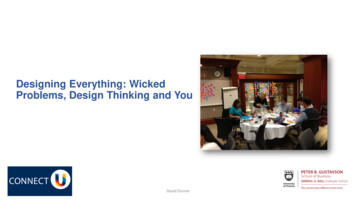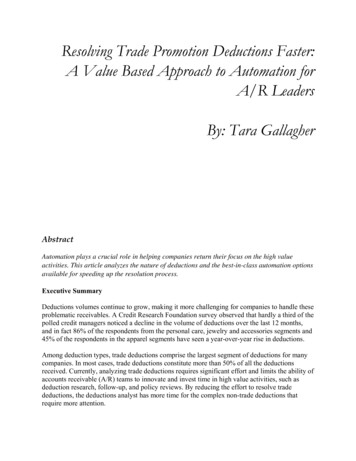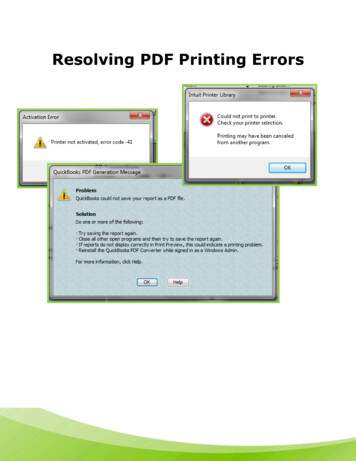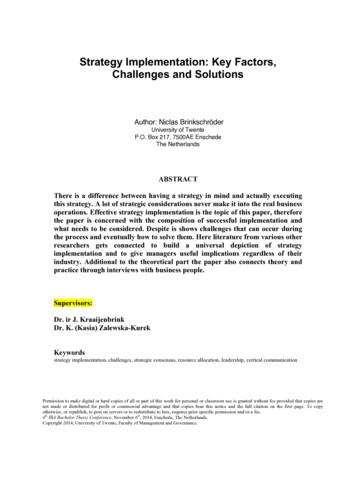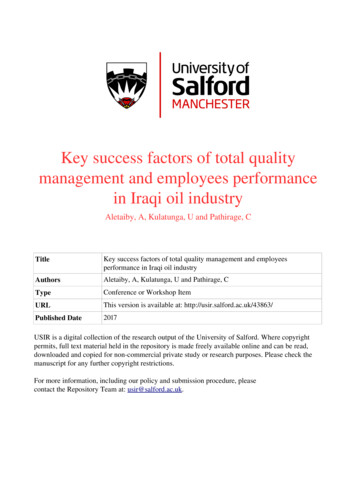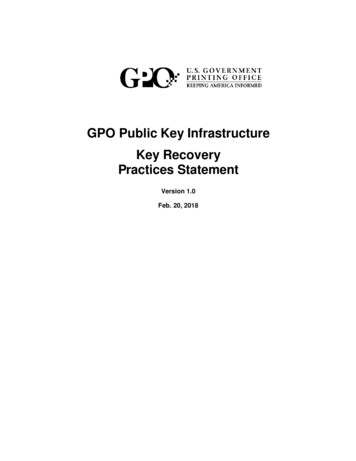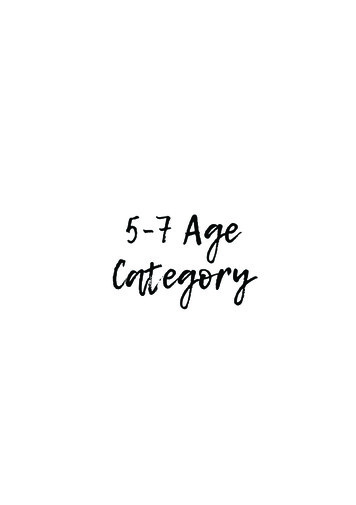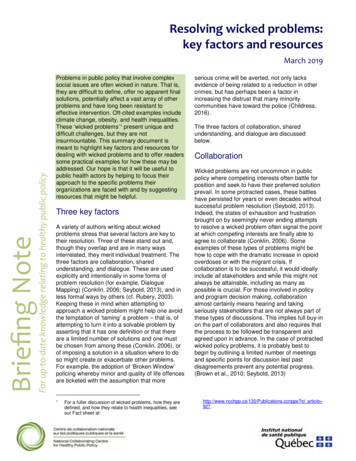
Transcription
Resolving wicked problems:key factors and resourcesBriefing NoteFor up-to-date knowledge relating to healthy public policyMarch 2019Problems in public policy that involve complexsocial issues are often wicked in nature. That is,they are difficult to define, offer no apparent finalsolutions, potentially affect a vast array of otherproblems and have long been resistant toeffective intervention. Oft-cited examples includeclimate change, obesity, and health inequalities.These ‘wicked problems’ 1 present unique anddifficult challenges, but they are notinsurmountable. This summary document ismeant to highlight key factors and resources fordealing with wicked problems and to offer readerssome practical examples for how these may beaddressed. Our hope is that it will be useful topublic health actors by helping to focus theirapproach to the specific problems theirorganizations are faced with and by suggestingresources that might be helpful.Three key factorsA variety of authors writing about wickedproblems stress that several factors are key totheir resolution. Three of these stand out and,though they overlap and are in many waysinterrelated, they merit individual treatment. Thethree factors are collaboration, sharedunderstanding, and dialogue. These are usedexplicitly and intentionally in some forms ofproblem resolution (for example, DialogueMapping) (Conklin, 2006; Seybold, 2013), and inless formal ways by others (cf. Rubery, 2003).Keeping these in mind when attempting toapproach a wicked problem might help one avoidthe temptation of ‘taming’ a problem – that is, ofattempting to turn it into a solvable problem byasserting that it has one definition or that thereare a limited number of solutions and one mustbe chosen from among these (Conklin, 2006), orof imposing a solution in a situation where to doso might create or exacerbate other problems.For example, the adoption of ‘Broken Window’policing whereby minor and quality of life offencesare ticketed with the assumption that more1For a fuller discussion of wicked problems, how they aredefined, and how they relate to health inequalities, seeour Fact sheet at:serious crime will be averted, not only lacksevidence of being related to a reduction in othercrimes, but has perhaps been a factor inincreasing the distrust that many minoritycommunities have toward the police (Childress,2016).The three factors of collaboration, sharedunderstanding, and dialogue are discussedbelow.CollaborationWicked problems are not uncommon in publicpolicy where competing interests often battle forposition and seek to have their preferred solutionprevail. In some protracted cases, these battleshave persisted for years or even decades withoutsuccessful problem resolution (Seybold, 2013).Indeed, the states of exhaustion and frustrationbrought on by seemingly never ending attemptsto resolve a wicked problem often signal the pointat which competing interests are finally able toagree to collaborate (Conklin, 2006). Someexamples of these types of problems might behow to cope with the dramatic increase in opioidoverdoses or with the migrant crisis. Ifcollaboration is to be successful, it would ideallyinclude all stakeholders and while this might notalways be attainable, including as many aspossible is crucial. For those involved in policyand program decision making, collaborationalmost certainly means hearing and takingseriously stakeholders that are not always part ofthese types of discussions. This implies full buy-inon the part of collaborators and also requires thatthe process to be followed be transparent andagreed upon in advance. In the case of protractedwicked policy problems, it is probably best tobegin by outlining a limited number of meetingsand specific points for discussion lest pastdisagreements prevent any potential progress.(Brown et al., 2010; Seybold, id article 927.
2Briefing NoteResolving wicked problems: key factors and resourcesShared UnderstandingShared understanding refers not to agreement on allof the issues but to an understanding of each pointof view and a commitment to documenting theprocess of collaboration in such a way that it allowsall participants to see – usually in a visualThis type of visual representation is particularlyuseful when collaborating over a period of time(Seybold, 2013). Because everyone has access to aquick summary of how issues have been discussed,there is no need to return to past discussions or towaste time and energy rehashing old arguments(Conklin, 2006, p. 53). It can also leave participantswith a representation of the ground they havecovered and a sense of accomplishment inadvancing towards a possible resolution.2representation – that their views and positions aregiven equal weight. The diagram below shows anexample of how mapping out a dialogue processmight capture a discussion. Each idea, question, andargument for or against is represented on the mapand remains there as both a memory aid and as arepresentation of the discussion. 2Benefits of shared understanding Reduction in duplicated effort and rework Minimized number of issues that fall through thecracks Coherent individual efforts that move the groupforward Decisions that stick Better visibility of critical issuesThis example is a very simplified version of a Dialogue Map(Conklin, 2006). The formal version uses a specific softwaretool (Compendium), not used here and a language – Issuebased information system (IBIS) - that is only approximated inTel.: 514 864-1600 ext. 3615 Email: ncchpp@inspq.qc.cathis rendering. For direction to a full account of the DialogueMapping process, see the Resources section of thisdocument. Twitter: @NCCHPP ncchpp.ca
Briefing NoteResolving wicked problems: key factors and resources Lasting impact on group’s productivity Fewer and better meetings(Cognexus Group, n.d.)Shared understanding also implies that participantscommit to attempting to understand the points ofview of other collaborating partners. Understandinghow different groups frame a problem or see it asaffecting them and their lives is crucial in buildingcommon ground towards resolving a wickedproblem. Within many policy circles, certainly thosethat deal with public health, scientific evidence isconsidered the most critical information and a basisfor action on its own. This frame, however powerfulin scientific and medical circles, is often not the mostcentral one when it comes to many wicked policyissues. Rubery (2003), for example, discusses therise in vaccine hesitancy of parents who have fearsabout the effects of immunization:“Parents are naturally concerned for the safetyof their child, that is their responsibility. TheGovernment and public health doctors look atthe same issue from a population point ofview, because that is what they are trained todo. Neither perspective is ‘wrong’, buttensions can arise if there is not somerecognition of the fact that these differentperspectives mean that the same data isviewed and valued differently by the twogroups when making a decision. If the twosides start to lose sympathy with each otherand demonise the ‘other side’, then rigiditysets in, people start to call for the ‘truth’ aboutthe issue ( ), and progress towards anagreed way forward becomes increasinglyproblematic.” (Rubery, 2003 p.4)3DialogueIf collaboration is the basis upon which wickedproblems can begin to be resolved and sharedunderstanding is an important path to getting there,dialogue, whether in one of the many more formalprocesses of deliberation or in ways which are lessstructured, is the key to both (Browne et al., 2010;Seybold, 2013). The table below presents thecharacteristics and goals of discussion, debate, anddialogue and clearly illustrates that when grapplingwith most policy and program issues, it is mostcommon to find people engaging in a combination ofdiscussion and debate and only rarely are attemptsmade to resolve problems through dialogue. Withwicked problems, however, it has been shown to bean invaluable tool. 3 There are a number of differentpractical exercises that a collaborating group canparticipate in, including ones focused on activelistening and on how to ask exploratory questionsand mirror (repeat the ideas and claims of otherparticipating members in order to ensure a full andagreed upon understanding of each other’sviewpoint) each other. 4 Having participants agree toengage in such a process requires that they enterinto it knowing that they will be asked to listen todiverging positions and resist the temptation to‘convert’ other members to their point of view. Thesuccess of such a process can be measured by theextent to which members are able to understanddifferent positions, find shared meanings and finally,find the spaces of agreement which will allow themto move forward.It is less important then, that all parties agree on adefinition or cause of a problem than that they cometo share an understanding of each position andaccept its validity. This, although not easy, can beaccomplished through collaboration and dialogue.3See, for example, The Delta Dialogues, in the Resourcessection below.Tel.: 514 864-1600 ext. 3615 Email: ncchpp@inspq.qc.ca4See The Dialogue Handbook in the Resources section. Twitter: @NCCHPP ncchpp.ca
4Briefing NoteResolving wicked problems: key factors and resourcesTable 1The Characteristics and Goals of Discussion, Debate, and DialogueDiscussionDebateDialoguePresent ideasSucceed or winBroaden perspectivesSeek answers or solutionsLook for weaknessLook for shared meaningPersuade othersStress disagreementFind spaces of agreementShare informationFocus on ‘right’ and ‘wrong’Bring out ambivalencesSolve our problemsAdvocate one perspectiveInvite/allow differences of opinionand expertiseGive answersSearch for logic flawsDiscover collective meaningAchieve preset goalsJudge other perspectives as inferioror distortedChallenge our preconceived notionsListen for disagreementListen in order to counterListen in order to understandAvoid areas of conflict and differenceFocus on conflict and difference asadvantageArticulate areas of conflict anddifferenceRetain relationshipsDisregard relationshipsBuild relationshipsSource: adapted from Kachawa, 2002.DIALOGUE MAPPINGResourcesThe resources listed here are likely to be helpful topublic health actors faced with wicked problems intheir organizations, whether these involve largescale problems that affect broad segments of thepopulations they serve or more circumscribedresistant organizational problems that impede theirwork on a narrower scale. Each of the resourcesdeals with one, two, or all three of the key factors ofcollaboration, shared understanding, and/or dialoguebut, where appropriate, the factors most clearlyassociated with each are underlined and boldedinside the boxes at the beginning of the entry. It ishoped that all of them will prove useful whether thatbe in providing conceptual, descriptive, or practicaltools or, as in two of the cases, as detailed examplesof how dialogue and group deliberation have beenused elsewhere.CollaborationShared UnderstandingDialogueDialogue Mapping is a tool designed for dealing withwicked problems. This book of the same title detailsthe context, theoretical underpinnings and specifictechniques for the process. Jeff Conklin, a leader inwicked problem research and resolution, providesguidelines for conducting Dialogue Mappingsessions using the two primary tools: Compendium(a software program) and Issue-based informationsystem, or IBIS (a language used for problemsolving). This resource is the go-to book for DialogueMappers and contains valuable information on howto approach mapping as a means of resolvingwicked problems.For more information:http://www.cognexus.org/dm book.htmTel.: 514 864-1600 ext. 3615 Email: ncchpp@inspq.qc.ca Twitter: @NCCHPP ncchpp.ca
Briefing NoteResolving wicked problems: key factors and resourcesCOGNEXUS GROUPCollaboration5TOM WUJEC ON MAPPINGShared UnderstandingDialogueJeff Conklin, author of the Dialogue Mapping bookoutlined in the previous section, is the founder andPresident of the Cognexus Group, and their generalwebsite provides ideas and tools, with furtherexamples of the use of Dialogue Mapping inunderstanding and dealing with wicked problems.For more information: http://cognexusgroup.comCollaborationShared UnderstandingDialogueIn this short TED Talk, Tom Wujec presents thevalue of collaboration and mapping in understandingand resolving wicked problems. This resource isparticularly useful for addressing organizationalproblems and challenges.For more information:https://www.ted.com/talks/tom wujec got a wickedproblem first tell me how you make toastHELP! I HAVE TO THINK!THE DELTA DIALOGUESCollaborationShared UnderstandingDialogueCollaborationThis book and content on the related website iswritten by long-time Dialogue Mapping instructor andpractitioner KC Burgess Yakemovic and provides aneveryday user guide to mapping questions, bothtame and wicked, using IBIS (Issue-basedinformation system) and simplified mapping tools(from software to pen and paper). Yakemovic’s toolsare easy to understand and use without losing theability to grapple with complex issues. This resourceis a very useful introduction to using ‘IBIS thinking’as a way to capture dialogue.For more information: http://helpihavetothink.comTHE DIALOGUE HANDBOOKCollaborationShared UnderstandingDialogueMette Lindgren Helde’s resource, The DialogueHandbook – the art of conducting a dialogue andfacilitating dialogue workshops, includes a generalintroduction to dialogue and its uses and provides agreat number of examples of exercises, differenttypes of dialogues and dialogue facilitation. Thishandbook is an invaluable resource for anyonelooking to work through problems and issues theymay face in their work or their organizations.For more dialoguehandbook/Tel.: 514 864-1600 ext. 3615 Email: ncchpp@i
wicked problems. This book of the same title details the context, theoretical underpinnings and specific techniques for the process. Jeff Conklin, a leader in wicked problem research and resolution, provides guidelines for conducting Dialogue Mapping sessions using the two primary tools: Compendium (a software program) and Issue-based information system, or IBIS (a language used for problem .File Size: 621KBPage Count: 7

